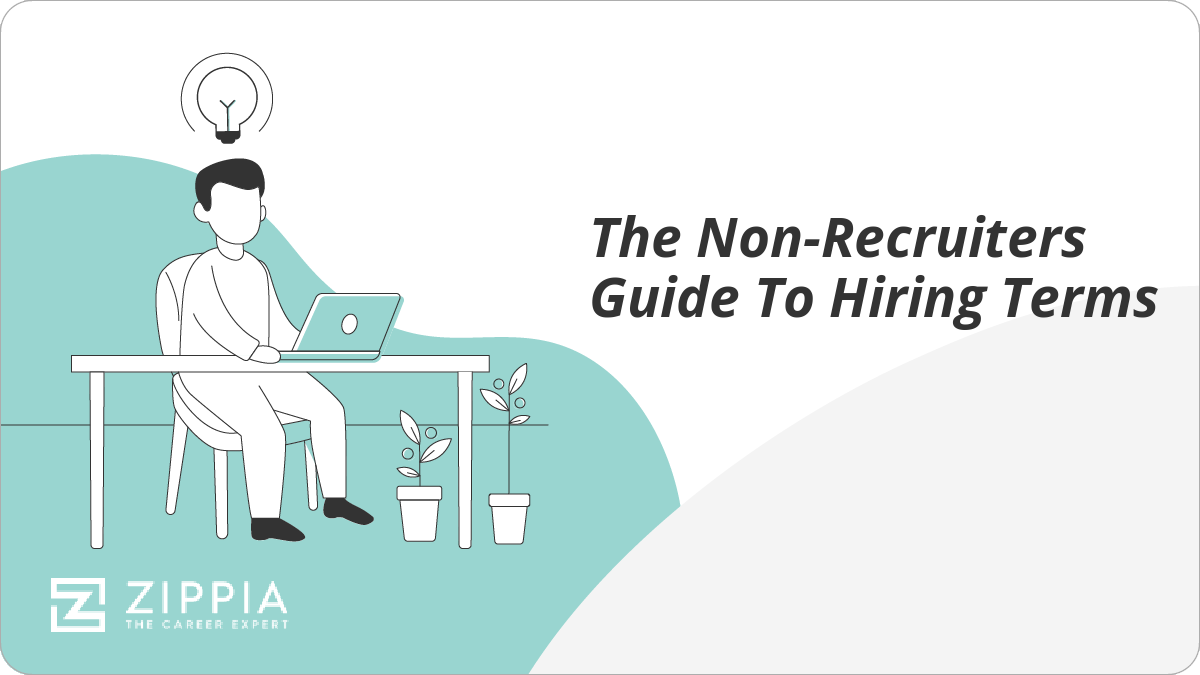Has a recruiter ever excitedly told you that after rejecting all the job hoppers they’ve found a ‘purple squirrel’ on gardening leave?
Maybe they’ve suggested a Stay interview or Job Shadowing your current CXO level employees before attempting to poach from your competitors?
Before you think they’ve joined Alice and the Mad Hatter in Wonderland, or that they may need a referral to a good therapist, check out these typical recruitment terms and their meanings below.
Key Takeaways:
-
Recruitment refers to the overall process of attracting, selecting and appointing suitable candidates for jobs within an organization.
-
While hiring, the types of candidates that you can come across are passive and active candidates.
-
It’s important to understand the different types of interviews that way you can use the correct one when you start your interview process.

Types of Recruiters
-
Head Hunter. A recruiter who focuses on searching for qualified personnel for typically senior roles, sometimes referred to as executive search, usually by approaching those who may not be actively looking for a new job.
-
Niche Recruiter. Refers to a recruiter who operates solely within a specific field. Also often referred to as Boutique Recruiters.
-
Generalist Recruiter. This is a recruiter who offers their services across multiple fields or disciplines.
-
Independent Recruiter. A recruiter who works on their own (as opposed to being employed by an agency) offering their recruitment services to clients either on a contingent basis or at an hourly rate.
Candidate Related Terms
-
Purple Squirrel. Purple squirrel is a term used by employment recruiters to describe a job candidate with precisely the right education, experience, and qualifications that perfectly fits a job’s multifaceted requirements. The implication is that the perfect candidate is as rare as a real-life purple squirrel.
-
Active Candidate. Refers to someone who is actively looking for a new position. They’ve registered with a recruitment agency; they have automatic feeds coming in from job boards; and they’re definitely keen to hear about new opportunities.
-
Passive Candidate. This is someone who is happy in their current role. They are certainly not on the lookout for a new opportunity, but if they are tapped on the shoulder, they may be open to meet for a coffee.
Passive candidates represent a huge, largely untapped pool of qualified workers who may fit the needs of your company perfectly. In order to reach them, adjust your hiring strategy to identify their points of concern and sell them not just on a job, but on an opportunity.
-
Applicant Pool. Some people use the phrase ‘applicant pool’ to describe the group of candidates who have actually applied for a position. Others see it more as the group of potential candidates ‘out there’ who might be available or interested a certain role.
-
Job Hopper. A reference to someone who doesn’t stay at one job for a long time.
-
Transferrable Skills. Refer to a candidate’s skills that are able to be utilized in a variety of industries or across a number of different types of jobs.
Types of Positions
-
Maternity Leave Cover. When an employee leaves an organization for a period of time to have a baby. In some countries their job is guaranteed to them when they get back. Maternity leave contracts are understood to only be for a relatively short period of time.
-
Internship. This is usually an unpaid position for someone seeking to gain relevant work experience. Some internships are paid but the rate is usually lower than standard.
-
Executive Search. Executive recruitment usually relates to jobs over $100K and some way up the management ladder.
-
C-level Jobs. Based on positions such as ‘CEO, CIO, and CTO’, C-level jobs are top level jobs denoting management of a particular aspect of the company. Sometimes also referred to as CXO or C-Suite roles.
-
Entry Level Job. A job that does not require experience, usually aimed at candidates straight out of college.
-
Job Shadowing. When an employee (or perhaps even a recruiter) spends time with another employee in a similar or higher position to that being advertised in order to learn more about the role.
-
Lateral Job Transfer. An opportunity to move into another position within the organization with the same level of responsibility or pay but typically in a different department.
-
Returnship. This is a term for an internship specifically designed for professionals looking to return after a period of time out of the workforce.
Job Lingo
-
Compensation/Salary. This refers to the amount of money (not including benefits) the employee will receive in return for the work done in a specific role.
-
Benefits. These are the non-cash incentives that are provided over and above the salary. For example, cars, fuel allowance, gym membership, a car spot, flexible hours, or lunch from the canteen every day. Also known as ‘Perks’.
-
Work-Life Balance. Assuming this can be achieved, it refers to the ratio of time spent at work to time spent outside of work. Employees like to think an organization will provide them with work life balance.
-
On Target Earnings (OTE). Most commonly seen in sales-related positions, this is the estimated amount an employee will receive assuming they meet all their targets and therefore qualify for all their commissions.
-
Depending On Experience (DOE). A reference to when a salary is dependent on the amount of experience a candidate has.
-
Piece Rate. This refers to when an employee is paid purely based on the amount of pieces or actual items they produce.
-
Comp time or Time In Lieu. Rather than paying overtime, a company may offer comp time or time in lieu, meaning an employee does not have to come in to work for the duration of the hours they have worked overtime.
-
Employee Assistance Program. This is a program implemented by an organization to provide benefits to its employees.
Internal Recruitment Terms
-
Recruitment. Recruitment refers to the overall process of attracting, selecting and appointing suitable candidates for jobs (either permanent or temporary) within an organization. Recruitment can also refer to processes involved in choosing individuals for unpaid positions, such as voluntary roles or unpaid trainee roles.
Managers, human resource generalists and recruitment specialists may be tasked with carrying out recruitment, but in some cases public-sector employment agencies, commercial recruitment agencies, or specialist search consultancies are used to undertake parts of the process.
-
Recruitment Process Outsourcing. Recruitment Process Outsourcing (RPO) is a form of business process outsourcing (BPO) where an employer transfers all or part of its recruitment processes to an external service provider. An RPO provider can provide its own or may assume the company’s staff, technology, methodologies and reporting. RPO differs from providers such as staffing companies and contingent/retained search providers in that it assumes ownership of the design and management of the recruitment process and the responsibility of results.
-
Applicant Tracking System. Refers to the software an organization might use to automate many of the processes needed to manage the recruitment process internally.
-
Human Resources. Typically internal staff who assist the organization in employee management. The Human Resources team may often engage recruiters to find appropriate candidates.
-
Talent Management. A program for managing the people within an organization in order to grow or attract top talent.
-
Social Recruiting. Social recruiting (social hiring or social media recruitment) is recruiting candidates by using social platforms as talent databases or for advertising. Social recruiting uses social media profiles, blogs, and other Internet sites to find information on candidates.
-
Talent Brand. The way your company appears to talent – in other words employees or prospective employees. It’s also referred to as the Employer Brand.
-
Orientation. The introduction, or onboarding process given to a new employee to get them familiar with their job and the workplace.
-
Sourcing. Sourcing is the use of one or more strategies to attract or identify candidates to fill job vacancies. It may involve internal and/or external recruitment advertising, using appropriate media, such as job portals, local or national newspapers, specialist recruitment media, professional publications, window advertisements, job centers, or in a variety of ways via the internet.
Types of Interviews
-
Assessment Center. Entire half day programs specifically designed around a particular function (eg sales or customer service) where all candidates perform in role plays and participate in group exercises. Most commonly used for volume hiring campaigns.
-
Group Interview. Similar to an assessment center, designed around volume hiring needs when interviews are conducted in a group rather than individually.
-
Prescreen/Screening Interview. An initial conversation, usually over the phone (or perhaps a video interview) conducted to ascertain whether a candidate is worthy of being invited in for a face-to-face interview.
-
Unstructured Interview. This refers to an interview where the interviewer does not follow a formal list of behavioural or competency based questions.
-
Stay Interview. An interview conducted with an employee who currently works at an organization to work out what motivates them and why they enjoy working there. Contrast this with an exit interview.
-
Behavioral Based Interview. An interview conducted in a manner to find out how a candidate behaves in a particular situation – typically involving a series of questions asking a candidate to discuss past experiences.
-
Case Interview. An interview conducted where candidates are given a business case scenario to review to then present on.
-
Open Job Interview. A few companies are starting to adopt this method whereby any applicants interested in applying for a role can attend interviews conducted at a range of times that work for them.
-
Panel Interview. Where one candidate is interviewed by a number of people – for example a member of the HR team, a line manager, and perhaps a senior manager.
Candidate Attraction and Selection
-
Hidden Job Market. This is a phrase referring to available jobs that are not listed on job boards or in press ads.
-
KSA. This acronym refers to Knowledge, Skills and Abilities and relates to the characteristics required to perform a job correctly.
-
Buy Back. When an employee resigns but is offered more money to stay with their current employer. This is also sometimes referred to as a “Counter Offer”.
-
Offer Letter. The documentation formally confirming the offer of a job to the preferred candidate.
-
Insourcing. When a candidate is recruited into a new role in the organization from within the business.
-
Outsourcing. When a company contracts another organization to perform a function rather than employing a person directly to do it internally.
-
Offshoring. This refers to the process of hiring talent based overseas in a country where the labor is much cheaper.
-
In-House. When a function is performed by an employee within the business rather than a third party company. For instance in-house recruitment means the organization has employed an internal recruiter rather than asking a recruitment firm or independent contract recruiter to get involved.
-
Talent Acquisition. A fancy term for the strategy used to attract and hire the best people.
-
Poaching. Refers to ‘stealing’ an employee directly from a competing company.
-
Referral Bonus. One of the many strategies employed by organizations to reduce their recruitment spend. Current employees are offered a sum of money for referring a candidate, who then accepts a position and successfully passes their probation.
-
Covering Letter. The personal introduction from a candidate prefacing their CV, outlining who they are, what they are looking for, and why they feel they are suited to a particular role.
-
Referees. Those individuals (typically previous managers) willing to provide personal testimonials around a candidate’s skills, behaviors, and past performance.
Termination
-
Gardening Leave. Sometimes when an employee resigns they are told not to come back to the office during their notice period. They are technically still employed and need to be available to the organization. It is often known as ‘being walked’ as the employee is usually accompanied to their desk to collect their belongings immediately after resigning.
-
Severance Pay. Refers to the amount of money given to employees when they are terminated from a position.
-
Downsizing. When a company permanently reduces its work force, usually resulting in many layoffs and redundancies.
-
Redundancy. When a person is let go not because of a performance issue, but because their position is no longer required within the business. This is typically accompanied by a compensation / redundancy package.
-
Exit Interview. A formal interview conducted after an employee resigns but before they actually leave the organization to find out the reasons for leaving and ideally garner information the company can use to improve.
-
Non-Compete. This refers to a clause in many employment contracts where the employee agrees not to work for a competing business for a specific period of time. This is often referred to as a “Restraint Clause”.
-
Outplacement. A post-termination service typically offered by larger organizations designed to help those who may have been made redundant locate a new job based on their skills.
Hiring Terms FAQ
-
What is the golden rule of hiring?
The golden rule of hiring is to treat other how you would like to be treated. You should especially do this when working with potential candidates. No one want’s to be treated poorly, so just make sure you are being nice to everyone so that way you make a good first impression with anyone.
-
What are red flags in hiring?
A red flag while hiring is when a candidate asks a lot of questions about salary, promotions, or benefits during the first interview. A candidate should ask some questions about these topics, but not during the first interview. If they are only asking questions about what they can benefit from, they might not care what you will be putting in to the company.
-
What are the stages of the recruitment process?
There are 7 steps in the recruitment process and they include:
-
Planning
-
Analysis
-
Searching
-
Screening
-
Engagement
-
Selection
-
Onboarding
-
-
What is a common hiring mistake?
A common hiring mistake is failing to prepare. It’s important to prepare to know who you are hiring. You should make sure that the person that you are hiring is qualified and you do the necessary background checks to make sure they are telling you the truth.
- Recruitment Tips
- The Non-Recruiters Guide To Hiring Terms
- How To Improve Recruiting When You Have Bad Reputation
- How To Avoid Stereotyping While Recruiting
- Data Protection Tips For Recruiters
- Steve Jobs' Top Hiring Tips
- Bad Hiring Experiences For Candidates
- Networking Advice From Recruitment Experts
- How Recruiters And Hiring Managers Can Work Together
- How To Use Boolean Search To Find Talent On Google
- The Latest Recruitment Trends
- How The Big Companies Hire
- Signs You're About To Lose A Top Candidate
- Get Candidates To Apply By Thinking Like A Marketer
- How To Recruit





